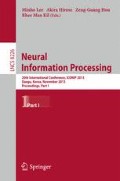Abstract
In this paper, we propose a recurrent neural network that can flexibly make inferences to satisfy given Boolean constraints. In our proposed network, each Boolean variable is represented in dual representation by a pair of neurons, which can handle four states of true, false, unknown, and contradiction. We successfully import Blake’s classical Boolean reasoning algorithm to recurrent neural network with hidden neurons of Boolean product terms. For symmetric Boolean functions, we designed an extended model of Boolean reasoning which can drastically reduce the hardware cost. Since our network has only excitatory connections, it does not suffer from oscillation and we can freely combine multiple Boolean constraints.
Access this chapter
Tax calculation will be finalised at checkout
Purchases are for personal use only
Preview
Unable to display preview. Download preview PDF.
References
Beller, S., Kuhnmünch, G.: What causal conditional reasoning tells us about people’s understanding of causality. Thinking & Reasoning 13(4), 426–460 (2007)
Blake, A.: Canonical expressions in Boolean algebra. University of Chicago (1938)
Brown, F.M.: Boolean reasoning: the logic of Boolean equations. Courier Dover Publications (2003)
Dietz, E.-A., Hölldobler, S., Ragni, M.: A computational logic approach to the suppression task. In: Proceedings of the 34th Annual Conference of the Cognitive Science Society, pp. 1500–1505 (2012)
Karnaugh, M.: The map method for synthesis of combinational logic circuits. Transactions of the American Institute of Electrical Engineers, Part I: Communication and Electronics 72(5), 593–599 (1953)
Kowalski, R.A.: The logical way to be artificially intelligent. In: Toni, F., Torroni, P. (eds.) CLIMA 2005. LNCS (LNAI), vol. 3900, pp. 1–22. Springer, Heidelberg (2006)
Malik, S., Zhang, L.: Boolean satisfiability from theoretical hardness to practical success. Communications of the ACM 52(8), 76–82 (2009)
Mandziuk, J., Macukow, B.: A neural network performing boolean logic operations. Optical Memory and Neural Networks 2(1), 17–35 (1993)
Mccluskey, E.J.: Minimization of Boolean functions. The Bell System Technical Journal 35(5), 1417–1444 (1956)
McMullen, C., Shearer, J.: Prime implicants, minimum covers, and the complexity of logic simplification. IEEE Transactions on Computers 100(8), 761–762 (1986)
Spears, W.M.: A nn algorithm for boolean satisfiability problems. In: IEEE International Conference on Neural Networks, vol. 2, pp. 1121–1126. IEEE (1996)
Stenning, K., Lambalgen, M.: Semantic interpretation as computation in nonmonotonic logic: The real meaning of the suppression task. Cognitive Science 29(6), 919–960 (2005)
Stenning, K., Van Lambalgen, M.: Human reasoning and cognitive science. The MIT Press (2008)
Tan, C.L., Quah, T.S., Teh, H.H.: An artificial neural network that models human decision making. Computer 29(3), 64–70 (1996)
Teh, H.H.: Neural Logic Networks: A New Class of Neural Networks. World Scientific (1995)
Wang, G., Shi, H.: Tmlnn: triple-valued or multiple-valued logic neural network. IEEE Transactions on Neural Networks 9(6), 1099–1117 (1998)
Wegener, I.: The complexity of boolean functions (1987)
Author information
Authors and Affiliations
Editor information
Editors and Affiliations
Rights and permissions
Copyright information
© 2013 Springer-Verlag Berlin Heidelberg
About this paper
Cite this paper
Chang, W., Song, H.A., Lee, SY. (2013). Flexible Reasoning of Boolean Constraints in Recurrent Neural Networks with Dual Representation. In: Lee, M., Hirose, A., Hou, ZG., Kil, R.M. (eds) Neural Information Processing. ICONIP 2013. Lecture Notes in Computer Science, vol 8226. Springer, Berlin, Heidelberg. https://doi.org/10.1007/978-3-642-42054-2_14
Download citation
DOI: https://doi.org/10.1007/978-3-642-42054-2_14
Publisher Name: Springer, Berlin, Heidelberg
Print ISBN: 978-3-642-42053-5
Online ISBN: 978-3-642-42054-2
eBook Packages: Computer ScienceComputer Science (R0)

